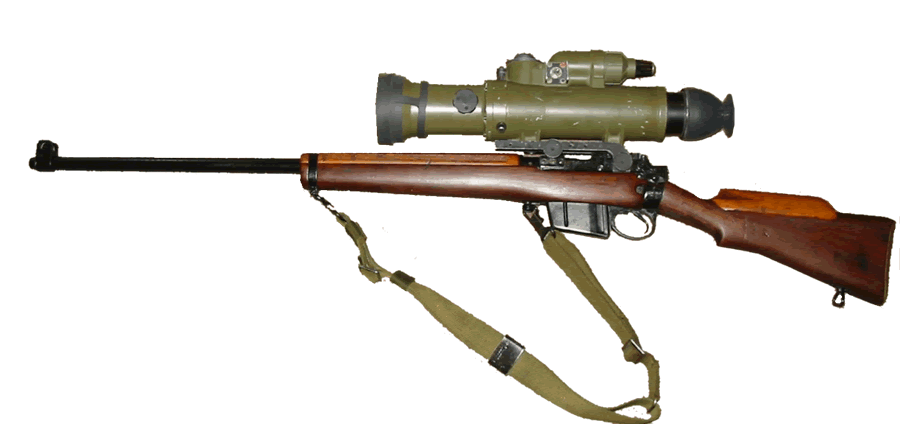The raison d'être for this website is as a reference point for British and Commonwealth training rifles (and rifles of BSA manufacture), most often in the form of conversions of full-bore service rifles to smaller calibres in the interest of economy in firing range requirements and ammunition; but an important aspect of our remit is recognition of the parent arms from which these conversions have evolved.
The No.4 Rifle has probably undergone more transmogrification, throughout its nearly 60 years of service, than almost any other British Service rifle. It has seen a change of calibre from .303" to the NATO 7.6mm ammunition, and seen use in nearly as many theatres as has the ubiquitous No.1 Rifle (the S.M.L.E.).
In its initial guise, the No.4 was still in fact a No.1 Rifle, in official terms at least, if not in much of its design. The basic method by which the barrel, action and woodwork were amalgamated showed little obvious change from the configuration of the original Lee-Metford and Enfield Magazine rifles. Dimensions had been adjusted over the years to suit contemporary needs, and the mechanics had been modified in a multiplicity of ways to advance the design, but the parentage of the No.4 was still easily recognised.
The S.M.L.E., or "Short, Magazine" Lee-Enfield rifle of 1903 had seen British forces through the First World War, or 'Great War to end all Wars' as it was known, and for many years after. Indeed, these rifles also saw considerable service during the early years of the Second World War (1939-1945) until production of the No.4 rifle started to make inroads into the heavy demand for such small-arms. In fact, Australia never manufactured the No.4, tooling being impracticable to duplicate during WWII; and that continent, and much of the Pacific theatre, saw the S.M.L.E. actioned rifles in use as much as any other British or Commonwealth small-arm. Only the atom-bombs' unprecedented destruction, bringing about a thankfully precipitate end to the conflict in the Pacific, put off further advancement of the S.M.L.E. in the form of the Rifle No.6, being the Antipodean equivalent to the British Rifle No.5, or "Jungle Carbine" as it became famously known.
The early 1930s heralded the design of the new rifle to replace the S.M.L.E., with the trialling of the first production batch, under the nomenclature "Rifle No.1 Mark VI", taking place in 1932. Its predecessor, the Mark V, had been built in a comparatively small production run of around 20,000 S.M.L.E. rifles that broke the tradition of open-sighted rifles in British service. However, the aperture rear-sight fitted to this rifle was relatively fragile and barely suitable for battle purposes. The new Mark VI rifle addressed this and many other factors. Successful trials saw little initial alteration to the design finally put into build, other than the to be expected adjustments in the interests of economy and simplification of production.
We illustrate the second most significant of these rifles. The first of the trials rifles was the 'pattern' rifle, serial number one, still held in the Pattern Room at the Leeds Royal Armouries, whilst the second is serial no.2 held in the Imperial War Museum.

Image by courtesy of the Trustees of the Imperial War Museum, London.
It is not our intention to present a comprehensive history of the No.4 rifle, such being readily available elsewhere in print and online; but we do hope to afford an introduction to assist in the understanding of the training rifles which have evolved from it. One interesting aspect of this, and indicative of the longevity of this rifle in its various marks, is the fact that both the N.9 .22RF 'No.9' training rifle, for the Royal Navy, and the L42A1, last of the full-bore Lee-Enfield line of sniper rifles, remained in service into the early 1970s, and beyond in a few specialised instances.
No.4T sniper rifles, built up by Holland & Holland during the latter years of WWII, underwent conversion to 7.62mm in 1971, as did many standard issue No.4 rifles similarly converted to provide reserve stocks in the 1960s; but these modified No.4Ts, with their heavy forged target-shooting type barrels, and now with the nomenclature L42A1, were still in service on the Falkland Islands several decades after. The wartime No.32 Mark 1 and 2 scopes had been modified yet again and calibrated in metres, and the ammunition was no longer rimmed, but the actions and, probably, the butt-stocks were already thirty years old.
We illustrate one such of these rifles, with the IWS (Individual Weapon Sight) - the First Generation image intensifying sight - mounted on the same pads as does the optical No.32 Scope "Straight Sighting". The weight and imbalance of the unit has to be experienced to be believed.This night-sight was also used on the L1A1 SLR (Self-Loading-Rifle) of Fabrique Nationale design, and on the SA80 Individual Weapon. The sight's transit case usually contained the mounting bracket adapters for each of these rifles. In addition, the sight was used either on a tripod or with a pistol-grip style handle for observation purposes, for instance on the border between Eire and Northern Ireland when British patrols were attempting to halt the clandestine night-time transfer of I.R.A. arms and personnel across the border.
More detail of this rifle can be found on the specific page for the Lee-Enfield Sniper Rifle L42A1

The No.4 was also a significantly effective long-range target rifle if correctly assembled, or "regulated" by an experienced gunsmith.
Edna "Ma" Parker of the Parker family, associated with the Parker-Hale gunsmithing group, wrote an article in the Guns Review Magazine of the 1980s covering the Lee-Enfield No.4 as a target rifle. This is shown below as a flip page PDF.
Double tap tablet or click ![]() for full page display.
for full page display.
See the conversions of the No.4 Rifle
The Royal Air Force .22RF No.7, the Royal Navy's Rifle No.9 and the .22RF No.4T sniping rifle for training.